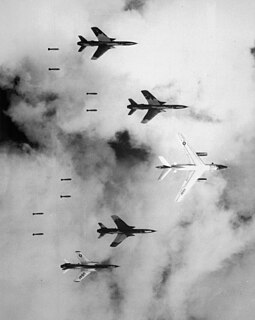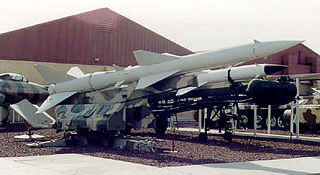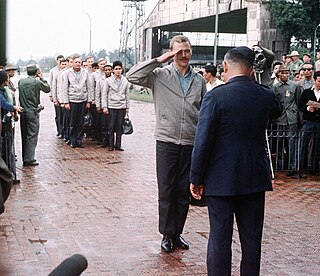
Hỏa Lò Prison was a prison used by the French colonists in French Indochina for political prisoners, and later by North Vietnam for U.S. prisoners of war during the Vietnam War. During this later period it was known to American POWs as the Hanoi Hilton. The prison was demolished during the 1990s, although the gatehouse remains as a museum.

Operation Rolling Thunder was the title of a gradual and sustained aerial bombardment campaign conducted by the U.S. 2nd Air Division, U.S. Navy, and Republic of Vietnam Air Force (VNAF) against the Democratic Republic of Vietnam from 2 March 1965 until 2 November 1968, during the Vietnam War.

The Republic F-105 Thunderchief was an American supersonic fighter-bomber used by the United States Air Force. The Mach 2 capable F-105 conducted the majority of strike bombing missions during the early years of the Vietnam War; it was the only American aircraft to have been removed from combat due to high loss rates. Originally designed as a single-seat, nuclear-attack aircraft, a two-seat Wild Weasel version was later developed for the specialized Suppression of Enemy Air Defenses (SEAD) role against surface-to-air missile sites. The F-105 was commonly known as the "Thud" by its crews.

Operation Linebacker II was a US Seventh Air Force and US Navy Task Force 77 aerial bombing campaign, conducted against targets in the Democratic Republic of Vietnam during the final period of US involvement in the Vietnam War. The operation was conducted from 18 to 29 December 1972, leading to several informal names such as "The December Raids" and "The Christmas Bombings". Unlike the Operation Rolling Thunder and Operation Linebacker interdiction operations, Linebacker II was to be a "maximum effort" bombing campaign to "destroy major target complexes in the Hanoi and Haiphong areas, which could only be accomplished by B-52s". It saw the largest heavy bomber strikes launched by the US Air Force since the end of World War II. Linebacker II was a modified extension of the Operation Linebacker bombings conducted from May to October, when the emphasis of the new campaign shifted to attacks by B-52s rather than smaller tactical fighter aircraft.
This is a list of aviation-related events from 1964:
This is a list of aviation-related events from 1967:

Operation Linebacker was the codename of a U.S. Seventh Air Force and U.S. Navy Task Force 77 air interdiction campaign conducted against the Democratic Republic of Vietnam from 9 May to 23 October 1972, during the Vietnam War.

Leo Keith Thorsness was a Colonel in the United States Air Force who received the Medal of Honor for his actions in the Vietnam War. He was awarded the medal for an air engagement on April 19, 1967. He was shot down two weeks later and spent six years in captivity in North Vietnam as a prisoner of war. After his military service, Thorsness served one term in the Washington State Senate.

The S-75 is a Soviet-designed, high-altitude air defence system, built around a surface-to-air missile with command guidance. Following its first deployment in 1957 it became one of the most widely deployed air defence systems in history. It scored the first destruction of an enemy aircraft by a surface-to-air missile, with the shooting down of a Taiwanese Martin RB-57D Canberra over China on 7 October 1959 that was hit by a salvo of three V-750 (1D) missiles at an altitude of 20 km (65,600 ft). This success was credited to Chinese fighter aircraft at the time in order to keep the S-75 program secret.

Hanoi Taxi is a Lockheed C-141 Starlifter strategic airlift aircraft that was in service with the United States Air Force and became famous for bringing back the first returned prisoners of war in Operation Homecoming. This aircraft, which was delivered to the Air Force in 1967, was the last C-141 to be withdrawn from service after a career of almost 40 years, as the last of the fleet was retired in 2006 as sufficient C-17 Globemaster III aircraft became available in the regular Air Force to allow C-141s still serving with Air Force Reserve units to be replaced by the C-5 Galaxy aircraft being seconded from the regular Air Force. The Hanoi Taxi is currently housed at the National Museum of the United States Air Force, near Dayton, Ohio.

Gia Lam Airport is an airport in Hanoi, Vietnam, located in Long Biên District, on the eastern bank of the Red River. It is primarily a military field, used by the Vietnam People's Air Force (VPAF), with MiG-21 fighters and Kamov Ka-28 helicopters stored in revetments. The airfield was inaugurated in 1936, before the Japanese occupation of French Indochina. The airport is currently used for military training activities, as well as for chartered helicopter taxi flights for tourists visiting nearby attractions such as Ha Long Bay. There are plans to convert Gia Lam to a civilian airport, serving short flights to and from locations in Northern Vietnam.

Operation Homecoming was the return of 591 American prisoners of war (POWs) held by North Vietnam following the Paris Peace Accords that ended U.S. involvement in the Vietnam War.

Bach Mai Airfield is a disused military airport in Thanh Xuan District, Hanoi, Vietnam, located along modern-day Le Trong Tan street. It was constructed by the French in 1917 and used by French forces until 1954; along with Gia Lam Airbase, it was one of the major logistics bases supporting French operations at Dien Bien Phu. After 1954, it was used by the Vietnamese People's Air Force and served as their air defense command and control center during the Second Indochina War, playing a part in the Cambodian–Vietnamese War as well. It is now the site of the Vietnam People's Air Force Museum, where a number of period military aircraft are on display.
Jacksel Markham "Jack" Broughton was a career officer and fighter pilot in the United States Air Force. He retired in the rank of colonel on August 31, 1968, with 43 separate awards and decorations, including four Distinguished Flying Crosses, two Silver Stars and the highest Air Force service decoration for heroism, the presidentially-awarded Air Force Cross. Broughton avowed that his proudest accomplishment was being combat-qualified in every air force fighter from the P-47 to the F-106. He authored two personal memoirs of the Vietnam War that were highly critical of the direction of the air war there and the rules of engagement.

The Vietnam People's Air Force is the air force of Vietnam. It is the successor of the former North Vietnamese Air Force and absorbed the Republic of Vietnam Air Force following the re-unification of Vietnam in 1975. The Vietnam People's Air Force (VPAF) is one of three main branches in the Vietnam People's Army which is a part of the Ministry of Defence. The main mission of the VPAF is the defence of Vietnamese airspace and the provision of air cover for operations of the People's Army of Vietnam.

The Action of 23 August 1967 was a major air battle which involved elements of the Vietnam People's Air Force (VPAF) and the United States Air Force (USAF). The air battle took place over the skies of North Vietnam as part of Operation Rolling Thunder, during the Vietnam War.

A Route Package were the names given by the US Air Force and US Navy to describe areas of air operations over North Vietnam. Generally referred to as "Route Pack" or even just "Pac" or "RP", each of the seven numbered areas represented a specific area of the country. Route Pack 1 was in the southernmost extremes of the country, on the border with South Vietnam. Route Pack 6, or 6B specifically, referred to the area around Hanoi and was considered to be the best defended airspace in the world at that time, and home to the dreaded Thud Ridge.



















